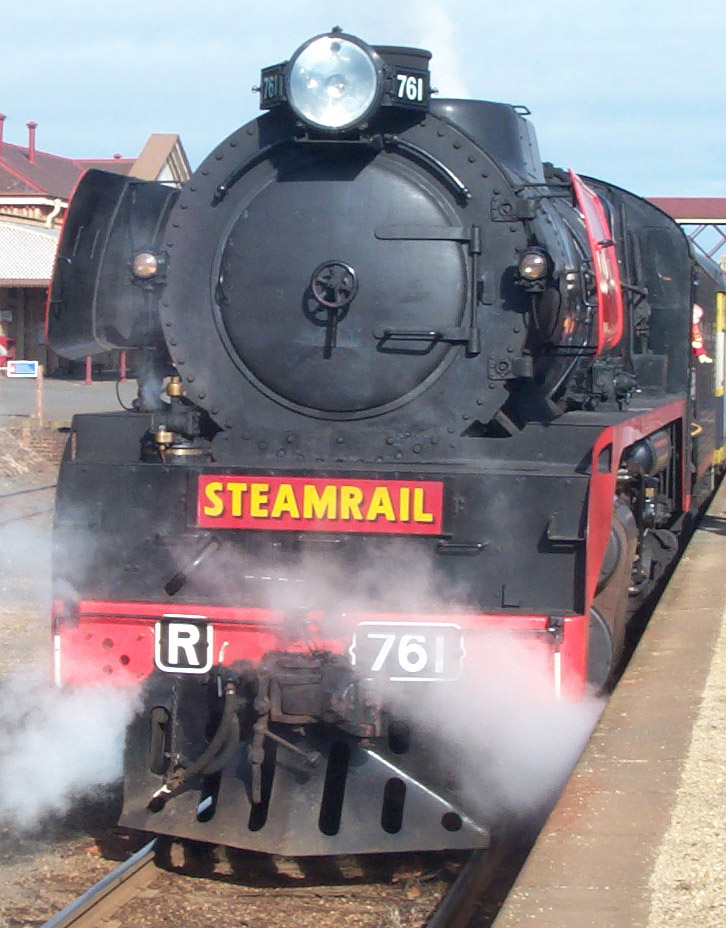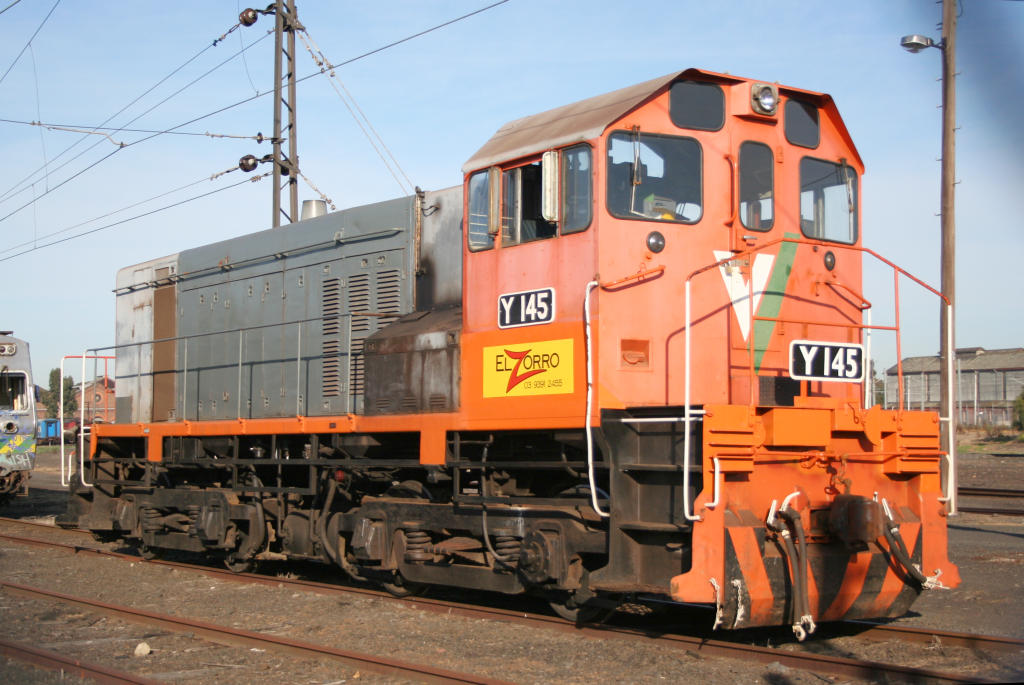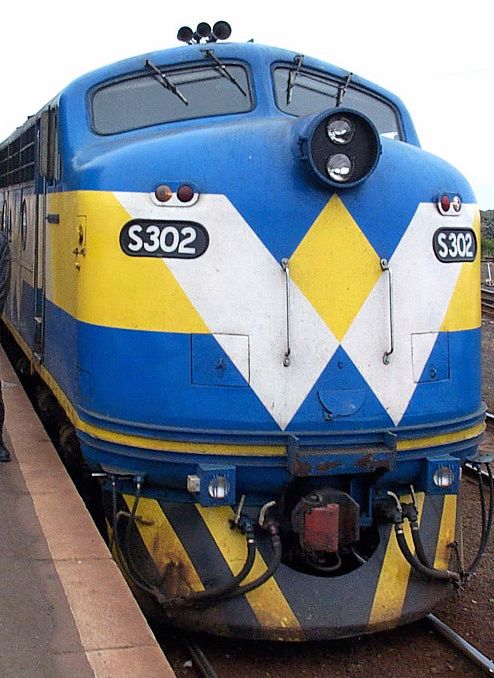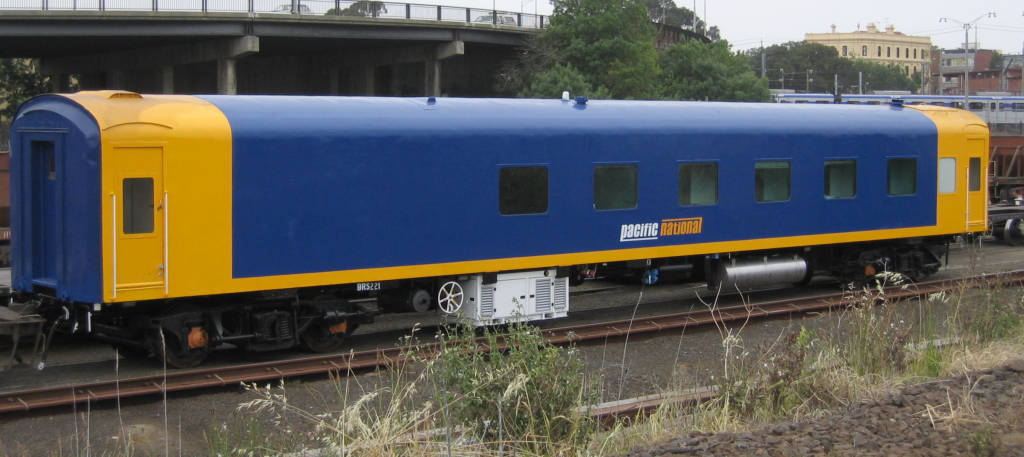|
707 Operations
707 Operations is a railway preservation group based in Melbourne, Australia. The volunteer organisation was established in 1980 to restore R class locomotive R707. The company has its own section of the Newport Workshops that is used for storing carriages and locomotives when not in use for trips (charter or regular). They are located in roads 7 and 8 of the Newport West Block Workshops. 707 Operations run regular trips across the broad gauge rail network in Victoria and also charter trains. People who motorcade the train to photograph it are asked to consider donating $10 towards the costs of running the train. This has been controversial among the railway fraternity. For the donation, 707 Operations provide a detailed schedule and tour notes 24 hours prior to departure and SMS updates should the train fall behind schedule in excess of 30 minutes. History In 1980, a committee of six men got together to inspect the withdrawn steam locomotive R707 at Newport Workshops. This lo ... [...More Info...] [...Related Items...] OR: [Wikipedia] [Google] [Baidu] |
R707-loco-victorian-railways
__NOTOC__ R7 or R-7 may refer to: Military * R-7 (missile), the world's first intercontinental ballistic missile, created by the Soviet Union * R-7 (rocket family), a family of expendable space launch vehicles, created by the Soviet Union * , a 1985 Invincible class British Royal Navy light aircraft carrier * USS ''R-7'' (SS-84), a 1919 R-class coastal and harbor defense submarine of the United States Navy Transport * R7 (Belgium), the Liège ring road * R7 Chestnut Hill East Line, a SEPTA rail route in Philadelphia, USA * R7 expressway (Czech Republic), an expressway in Czech Republic * R7 expressway (Slovakia), a planned expressway in southern Slovakia * R7/A (New York City Subway car), a model of rail rolling stock manufactured in 1937 * R7 (Rodalies de Catalunya), a rail line in Barcelona, Spain * R7 Trenton, a SEPTA rail route in Philadelphia, USA * Aserca Airlines, IATA designator R7, an airline based in Valencia, Venezuela * Radial Road 7 or R-7, an arterial road of Mani ... [...More Info...] [...Related Items...] OR: [Wikipedia] [Google] [Baidu] |
Melbourne
Melbourne ( ; Boonwurrung/Woiwurrung: ''Narrm'' or ''Naarm'') is the capital and most populous city of the Australian state of Victoria, and the second-most populous city in both Australia and Oceania. Its name generally refers to a metropolitan area known as Greater Melbourne, comprising an urban agglomeration of 31 local municipalities, although the name is also used specifically for the local municipality of City of Melbourne based around its central business area. The metropolis occupies much of the northern and eastern coastlines of Port Phillip Bay and spreads into the Mornington Peninsula, part of West Gippsland, as well as the hinterlands towards the Yarra Valley, the Dandenong and Macedon Ranges. It has a population over 5 million (19% of the population of Australia, as per 2021 census), mostly residing to the east side of the city centre, and its inhabitants are commonly referred to as "Melburnians". The area of Melbourne has been home to Aboriginal ... [...More Info...] [...Related Items...] OR: [Wikipedia] [Google] [Baidu] |
Victorian Railways R Class
The R class was an express passenger steam locomotive that ran on Australia's Victorian Railways (VR) from 1951 to 1974. A long overdue replacement for the 1907-era A2 class 4-6-0, their development and construction was repeatedly delayed due to financial constraints caused by the Great Depression and later the manpower and materials shortages of World War II and the immediate postwar period. Orders eventually totalling 70 locomotives were placed with the North British Locomotive Company of Glasgow. Once initial teething problems were overcome, R class locomotives proved to be a success and their power and speed enabled faster timetabled services. However, they were almost immediately superseded by mainline diesel-electric and electric locomotives on the Victorian Railways from 1952 onwards. With successive orders of diesel-electric locomotives through the 1950s and 1960s gradually displacing them, all but seven of the class were withdrawn and cut up for scrap. Four of the rema ... [...More Info...] [...Related Items...] OR: [Wikipedia] [Google] [Baidu] |
Newport Workshops
The Newport Railway Workshops is a facility in the Melbourne suburb of Newport, Victoria, Newport, Australia, that builds, maintains and refurbishes Rolling stock, railway rollingstock. It is located between the Williamstown railway line, Williamstown and Werribee railway lines. History Plans for a workshop at Newport started in the 1860s, to replace the temporary Williamstown Workshops but nothing came of it. It was not until 1880 that work began, when the Victorian Railways purchased annexes used at the Melbourne International Exhibition (1880), 1880 Melbourne Exhibition and erected one of them at Newport, naming it the Newport Carriage Workshops when it began operation in 1882. Construction of the permanent workshops commenced in 1884, and was completed in 1889. Although the earlier carriage workshop closed at this time, it reopened in 1895 to manufacture signal equipment. The first Railroad car, carriages built by the workshops were completed in 1889, but locomotives were ma ... [...More Info...] [...Related Items...] OR: [Wikipedia] [Google] [Baidu] |
Victorian Railways
The Victorian Railways (VR), trading from 1974 as VicRail, was the state-owned operator of most rail transport in the Australian state of Victoria from 1859 to 1983. The first railways in Victoria were private companies, but when these companies failed or defaulted, the Victorian Railways was established to take over their operations. Most of the lines operated by the Victorian Railways were of . However, the railways also operated up to five narrow gauge lines between 1898 and 1962, and a line between Albury and Melbourne from 1961. History Formation A Department of Railways was created in 1856 with the first appointment of staff. British engineer, George Christian Darbyshire was made first Engineer-in-Chief in 1857, and steered all railway construction work until his replacement by Thomas Higginbotham in 1860. In late 1876, New York consulting engineer Walton Evans arranged the supply of two 4-4-0 locomotives manufactured by the Rogers Locomotive Works of New Jersey, US ... [...More Info...] [...Related Items...] OR: [Wikipedia] [Google] [Baidu] |
Bacchus Marsh Railway Station
Bacchus Marsh railway station is located on the Serviceton line in Victoria, Australia. It serves the town of Bacchus Marsh, and it opened on 10 February 1887. A number of sidings once existed opposite the station and were used to stable trains. It also has an operational turntable, that is mainly used for turning steam locomotives on special trains. History Bacchus Marsh opened as the temporary terminus of the line from Melbourne. On 4 December 1889, the line was extended to Ballan, which completed the direct Melbourne to Ballarat line. The contract for the construction of the station building was awarded in 1889, for £1809/8/11. A 45 lever interlocking frame, in a signal box, was brought into use in 1890. By this time, the station had a main platform, with a dock platform at the eastern end, a main line and crossing loop, turntable, and a number of sidings. The station was originally provided with a turntable. In 1957, it was replaced by a 70-foot unit. s In the lat ... [...More Info...] [...Related Items...] OR: [Wikipedia] [Google] [Baidu] |
Victorian Railways F Class (diesel)
The F Class are a class of diesel locomotive shunters built by Dick Kerr Works for the Victorian Railways between 1951 and 1953. They are similar to the British Rail Class 11 and NS Class 600 shunting locomotives also built by English Electric during this period, but modified for use on the VR's 5 ft 3 in (1,600 mm) broad gauge (also known as Irish Gauge). History The F Class were ordered by the Victorian Railways as part of Operation Phoenix, a £80 million program to rebuild a network badly run down by years of Depression-era underinvestment and wartime overutilisation. The Victorian Railways purchased ten 0-6-0DE diesel shunting locomotives in 1951 from English Electric. The locomotives were built at EE's Preston workshops in the United Kingdom, and entered service from October 1951 onwards. The design is similar to that of the standard-gauge British Rail Class 11 and Nederlandse Spoorwegen 600 class locomotives, which were also being built by EE at this time ... [...More Info...] [...Related Items...] OR: [Wikipedia] [Google] [Baidu] |
Victorian Railways T Class
The T class are a class of diesel locomotives built by Clyde Engineering, Granville for the Victorian Railways between 1955 and 1968. History In July 1954, the Victorian Railways placed an order with Clyde Engineering for 25 (later extended to 27) diesel electric Electro-Motive Diesel G8 locomotives to partially dieselise country branch lines.1st Order (27 locos): T320-T346 & T413 (1 loco) Mark Bau's VR website In June 1959, the first of an additional ten entered service. Although mechanically similar to the first batch, they differed by having a cab raised above the hood line. Mark Bau's VR website A further ten entered service from Dece ... [...More Info...] [...Related Items...] OR: [Wikipedia] [Google] [Baidu] |
Victorian Railways Y Class (diesel)
The Y class are a class of diesel locomotives built by Clyde Engineering, Granville for the Victorian Railways between 1963 and 1968. History In 1963, the first of 25 general purpose diesel-electric locomotives was delivered by Clyde Engineering. As a cost saving measure, they were built with bogies and motors retrieved from scrapped Swing Door electric suburban train sets; the re-use of these components reduced the unit cost of the Y class locomotive from around £52,000 ( $104,000) to £40,000 ($80,000). Two further orders saw the class total 75 by 1968. Although built to dieselise Victoria's shunting operations and replace steam locomotives on branch line services, they were also used on mainline goods and passenger services, including between Spencer Street and Werribee. After closure of branch lines across the state and the end of short pick-up goods trains, use of the class dropped. In the 1980s, it is thought that four Y Class locomotives were on standard gauge, t ... [...More Info...] [...Related Items...] OR: [Wikipedia] [Google] [Baidu] |
West Coast Railway (Victoria)
West Coast Railway was a passenger train company operating in Victoria, Australia that operated services between Melbourne and Warrnambool from September 1993 until August 2004. The travel time for the journey (Warrnambool – Melbourne) was around 3 hours. This is on average around 30 minutes quicker than the current journeys. History West Coast Railway was formed in 1993 when the Kennett State Government offered long-distance country rail services previously run by the government-owned operator V/Line to private operators. Bids were lodged in February 1993 and West Coast Railway was announced as the successful tender on 30 April the same year. The initial franchise was for eight years with operations commencing on 19 September 1993. Subsequently, a three-year extension was negotiated. While most other rail services tendered were replaced by road coach services, West Coast Railway successfully tendered to retain a rail service. During the 11 years of WCR operation of the line ... [...More Info...] [...Related Items...] OR: [Wikipedia] [Google] [Baidu] |
S Type Carriage
The S type carriages are a corridor-type passenger carriage used on the railways of Victoria, Australia. The first carriages were constructed by the Victorian Railways in 1937 for use on the ''Spirit of Progress'', with additional carriages built for other trains until the mid-1950s. Introduced by Victorian Railways Chairman of Commissioners Harold Clapp for the ''Spirit of Progress'' service between Melbourne and Albury, the carriages lasted through many decades of regular service, with more than one operator. Two major variants of the S-type carriage were constructed: AS first-class cars with 3+3 seating in each compartment, and BS second-class cars with 4+4 seating. A handful of other cars were constructed for various specialist purposes. A number of conversions were carried out in later years, with the addition of beds to some to create sleeping cars, and buffet modules fitted to others to provide on-board catering facilities. The BRS buffet cars were the most recent co ... [...More Info...] [...Related Items...] OR: [Wikipedia] [Google] [Baidu] |
Z Type Carriage
The Z type carriages are an air conditioned steel passenger carriage used on the railways of Victoria, Australia. The carriages were constructed by the Victorian Railways from 1957 for use on intrastate services. Two major types of carriage were constructed - thirteen AZ first class cars with closely spaced but smaller windows, and twelve BZ second class cars with wider spaced but larger windows (the thirteenth BZ entered service on standard gauge). Carriages were provided with a saloon layout, with 2+2 reversible seating provided, with each row lining up with the windows. First class was provided with more legroom than second. An internal partition existed between the two ends of the saloon, but was removed in later years. A single twinette sleeping car was also built in a Z type body shell, entering service in 1963; it had 20 berths. A number of carriages were placed onto standard gauge bogies from 1962 for use on interstate trains such as the ''Spirit of Progress''. With ... [...More Info...] [...Related Items...] OR: [Wikipedia] [Google] [Baidu] |









